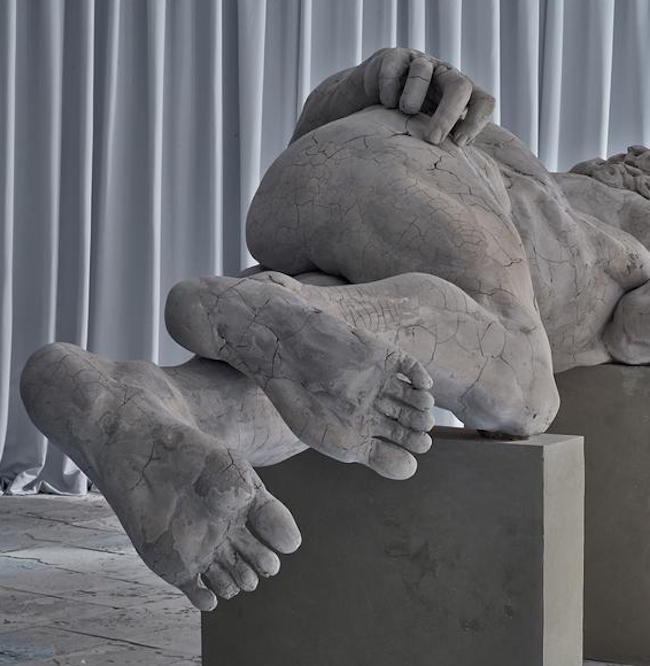Roberta Smith does not often get it wrong but her New York Times review for Adrián Villar Rojas’ installation Two Suns at Marian Goodman Gallery (New York, September 9 – October 10, 2015) casts him (literally) as working with concrete:
Adrián Villar Rojas excels at site-specific works that oscillate among historical, symbolic and spatial effects. One brought him wide attention when he represented Argentina at the 2011 Venice Biennale. Since then, he has become a staple at these large international exhibitions. Working mostly in situ in cast concrete with a team of assistants, he may have single-handedly made a complement of “festivalist art,” originally a pejorative coined for the grandiose installations of such shows.

Adrian Villar Rojas installation Two Suns at Marian Goodmann Gallery, New York City
Yes, he uses concrete in this show but it is blended with clay. Indeed, Villar Rojas is the grand master of terra cruda (‘uncooked’ clay) and concrete is usually part of the under-structure, not the surface. CFile has been following him closely, one of the very top artists in the clay-ceramics axis, including his new work (not clay but fiberglass) at the Istanbul Biennial.

Adrián Villar Rojas installation “Two Suns” at Marian Goodmann Gallery, New York City
David Boucher wrote an illuminating article on Artnet about the the exhibition and he takes the reader on a guided tour:
Entering from the elevator, visitors to the gallery find themselves in a completely empty, twilight space with a floor covered in cement tiles that seem the worse for wear. Some are black, some white, some gray, appearing as if they’d been laid down piecemeal. A few steps in and you’ll find that the tiles aren’t secured, so they slightly shift with each step. Look a little closer to see various objects embedded in the tiles—seashells, iPods, a bicycle tire.




The long corridor between the gallery’s two rooms is similarly lined with curtains, and since all electric lights are off for the duration of the exhibition, it takes a bit for the eyes to adjust. As you emerge into the south gallery, the star of the show comes into view: a full-size clay-and-cement replica of Michelangelo’s 17-foot-high sculpture David, lying on his side, propped up on two supports about four feet high.



David’s full-bodied backside faces the viewer, and he looks toward a wall with several windows that have never been exposed before; they’ve always been walled over. The show’s title, “Two Suns,” derives from the two sources of natural light, one from the windows to the south, one from those to the north, that are the show’s only illumination.

Somehow David is recognizable even from behind, although his pose is slightly modified from the original. As you come around to his front, you see that his alert gaze has given way; his eyes are closed, as if the Biblical slingman had fallen asleep on his way to slay Goliath.
Rojas’ choice of the classic sculpture was intentionally perverse, he explained. “I thought, ‘How can I get into trouble?’ Messing with David is a potential huge mistake.”
And mess with David he has. Besides giving way from erect to horizontal, watchful to dozing, David’s masculine majesty is further compromised. Rather than being confidently spread, his legs turn inward in a seeming gesture of modesty. His genitals are tucked away, such that you have to look closely to even be sure that they’re there. In that, Rojas’ David alludes to the ancient sculpture Sleeping Hermaphroditus, for which Gian Lorenzo Bernini famously provided a mattress in 1620.
Rojas is young (33 years) and seems to have unlimited ambition, taking on giant installations without any qualms. He builds on site and does not have a studio. He is also at ease with the instability of raw clay and its temporal quality but as he explained to Boucher what drew him to David was its seeming indestructibility:
Rojas’ works typically involve unfired clay that is meant to decay over time, so that the sculptures eventually collapse. Michelangelo’s massive work in marble appealed to Rojas in part precisely because of its longevity. “These iconic artworks have been stable so long,” he said, “that they offer some sort of confirmation of your own existence.”
Garth Clark is the Chief Editor of CFile.
Love contemporary ceramic art + design? Let us know in the comments!

Photographs courtesy of the artist and gallery.


This show was at Marian Goodman Gallery, New York – not Gladstone….
Nice work. .please tell me about crazing., and its variation. Secondly the frame s and material relationship. Thanks
What a beautiful surface of the cracked clay. Gives just a feeling of fragility to such a massive piece